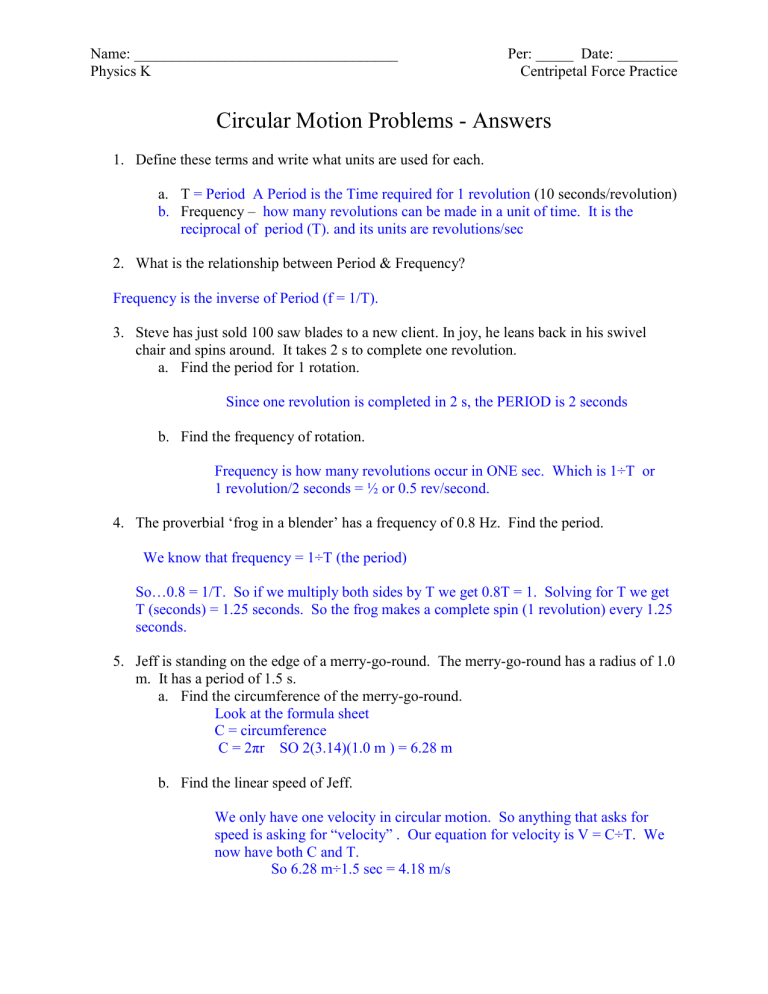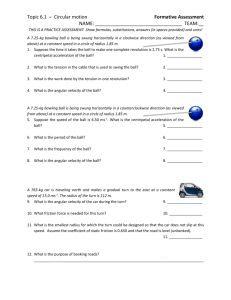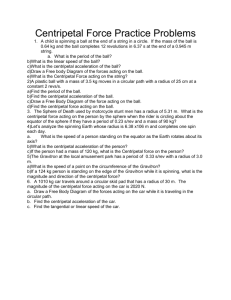Name

Name: ___________________________________
Physics K
Per: _____ Date: ________
Centripetal Force Practice
Circular Motion Problems - Answers
1.
Define these terms and write what units are used for each. a.
T = Period A Period is the Time required for 1 revolution (10 seconds/revolution) b.
Frequency – how many revolutions can be made in a unit of time. It is the reciprocal of period (T). and its units are revolutions/sec
2.
What is the relationship between Period & Frequency?
Frequency is the inverse of Period (f = 1/T).
3.
Steve has just sold 100 saw blades to a new client. In joy, he leans back in his swivel chair and spins around. It takes 2 s to complete one revolution. a.
Find the period for 1 rotation.
Since one revolution is completed in 2 s, the PERIOD is 2 seconds b.
Find the frequency of rotation.
Frequency is how many revolutions occur in ONE sec. Which is 1÷T or
1 revolution/2 seconds = ½ or 0.5 rev/second.
4.
The proverbial ‘frog in a blender’ has a frequency of 0.8 Hz. Find the period.
We know that frequency = 1÷T (the period)
So…0.8 = 1/T. So if we multiply both sides by T we get 0.8T = 1. Solving for T we get
T (seconds) = 1.25 seconds. So the frog makes a complete spin (1 revolution) every 1.25 seconds.
5.
Jeff is standing on the edge of a merry-go-round. The merry-go-round has a radius of 1.0 m. It has a period of 1.5 s. a.
Find the circumference of the merry-go-round.
Look at the formula sheet
C = circumference
C = 2πr SO 2(3.14)(1.0 m ) = 6.28 m b.
Find the linear speed of Jeff.
We only have one velocity in circular motion. So anything that asks for speed is asking for “velocity” . Our equation for velocity is V = C÷T. We now have both C and T.
So 6.28 m÷1.5 sec = 4.18 m/s
6.
A child is spinning a ball at the end of a string in a circle. The ball completes 12 revolutions in 6.37 s at the end of a 0.945 m string. a.
What is the period of the ball?
12 revolutions take 6.37 seconds
1 revolutions takes X seconds
Set up a cross multiplication 12 = 1
6.37
x
6.37 = 12x x = 6.37÷12 = .53 seconds for 1 revolution (which is T) b.
What is the linear speed of the ball?
Linear speed = velocity = C ÷ T
C = 2πr = 2(3.14)(.945 m) = 5.93 m
T = .53
SO….C÷T = 5.93÷.53 = 11.2 m/s (velocity)
Continuation of #6. Suppose you have additional information (as compared to #6)
2.
A child is spinning a ball at the end of a string in a circle. If the mass of the ball is 0.64 kg and the ball completes 12 revolutions in 6.37 s at the end of a 0.945 m string. a.
What is the period of the ball?
We know from the previous problem that: v = 11.2 m/s C = 5.93 m and T = .53 s
So…T is the period = .53 seconds r = .945 m= 0.64 kg b.
What is the linear speed of the ball? v = 11.2 m/s c.
What is the centripetal acceleration of the ball? a c
v
2 r
so (11.2) 2
÷.
945 m = 125.4 m 2 s 2 /.945 m = 133 m/s 2 d.
Draw a Free body Diagram of the forces acting on the ball. e.
What is the Centripetal Force acting on the ball? v
2
F c
m So 0.64kg * 133 m/s
2
= 85.12 Newtons r
3.
A plastic ball with a mass of 3.5 kg moves in a circular path with a radius of 25 cm at a constant frequency of 2 Hz. a.
Find the period of the ball. f = 2 = 1
÷T If 2 = 1
÷ T The 2T = 1 and T = ½ or 0.5 seconds b.
Find the linear velocity of the ball. v
C
2
r
T T
Here you MUST convert 25 cm to .25m
(2*3.14*.25m )÷.5 seconds = 4.64 m/s
c.
Find the centripetal acceleration of the ball. a c
v 2 r so (4.64m/s) 2
÷.
.25 m = 86.1 m / s 2 / d.
Draw a Free Body Diagram of the force acting on the ball. e.
Find the centripetal force acting on the ball.
4.
So 3.5 kg * 86.1 m/s
2
F
m v
2
= 301.4 Newtons equator of the sphere if they have a period of 0.23 s and a mass of 90 kg? r = 5.31 m To calculate force, we need to know velocity (we have everything else)
T = 0.23 s Since we know the radius and the period, we can calculate velocity, and then
M = 90 kg calculate Force v
T
2
T
V = 33.3 m÷.23 s = 144.8 m/s
We can now solve for force.
F c
m v r
2
5.31 m
2
= 2454 kgm/s
2
5.
According to the Guinness Book of World Records, the highest rotary speed ever attained was 2010 m/s. The rotating rod was 15.3 cm long. Assume the speed quoted was at the end of the rod. What force is acting on a 2.0 kg mass at the end of the rod?
You have everything you need. Just convert length to m.
F
m v
2
15.3 cm = .153 m = radius
Answer 2.0 (2010 m/s) 2 = 26,274.5 m/s 2
.153 m
6.
The Gravitron at the local amusement park has a period of 0.33 s with a radius of 3.0 m. a.
What is the speed of the speed of a point on the circumference of the Gravitron ?
Speed = circumference /period = 2πr /.33 seconds
2*3.14*3 m = 18.84 m = circumference 18.84/.33 = 57.2 m/s b.
If a 124 kg person is standing on the edge of the Gravitron while it is spinning, what is the magnitude and direction of the centripetal force?
The direction of centripetal force is ALWAYS toward the center.
Use the formula below for force, so use velocity from the last problem and the radius and the mass of the person to solve the problem
25 kg* (57.2 m/s)
F c
m v r
2
3 m
2 = 27265 Newtons
7.
A 1010 kg car travels around a circular skid pad that has a radius of 30 m. The magnitude of the centripetal force acting on the car is 2020 N. a.
Find the centripetal acceleration of the car.
F c
m v
2 r
Since acceleration is a c
v
2 r
You can plug in F (2020 N) and m (1010 kg ) and solve for acceleration
2020N = (1010 kg) (acceleration)
Acceleration = 2 m/s 2 b.
Find the tangential or linear speed of the car. ( means find v)
If a c
v 2 r and a c
= 2 m/s
2
and r = 30 m. Then v
2
= 2 m/s
2
(30 m) = 60 m
2
s
2
and v
= 7.7 m/s









